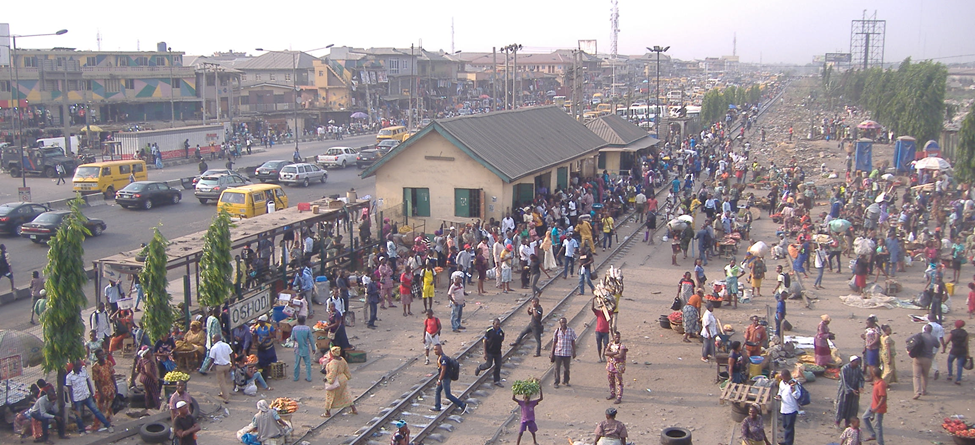Scholars, opinion makers, and journalists hold polarizing views on Africa’s development prospects. Likewise, professionals and global investors appear either bearish or bullish on Africa’s economic potential. These diverging views stem from how one is willing to envision Africa’s future. On the one hand, there are considerable investment opportunities as infrastructure is scant, firms and workers use little capital, and human capital lags. The most basic growth paradigms suggest ample space for catch-up growth, originating from (physical and human) capital accumulation. On the other hand, Africa’s past is marked by European extraction, slavery, coercion, and conflict. This troubling history, coupled with challenging topography and often hard-to-manage diversity, raises “poverty trap” concerns, keeps much-needed foreign capital away, and impedes Africa’s further integration into the global economy.
Two cover pages of The Economist illustrate these opposing views. In 2000, Africa was deemed the “Hopeless Continent.” A decade later, Africa was the “Hopeful Continent.” Interestingly, academic research in economics, political science, and history has followed a similar dynamic. “When Things Fell Apart”, between the 1970s and 1990s, there were only a handful of papers published outside specialized outlets. Since the 2000s, conversely, a vibrant stream of works on African political economy and economic history has come to life. The African Economic History Network – “intended to foster communication, collaboration, and research as well as teaching amongst scholars studying the long-term development of sub-Saharan Africa, from the precolonial era to the present-day” – is a vital part of this new research effort that differs considerably from earlier, pre-2000, research .
During the pre-2000 period, scholars realized that ill-fated post-independence policies, inefficient urban-rural agriculture policies, authoritarianism, civil conflict, corruption, and lack of structural transformation (the foci of pre-2000 studies) have deep historical roots. Thereafter, the new research agenda became more interdisciplinary, with economists empirically scrutinizing conjectures put forward by historians and political scientists. Likewise, political scientists and historians appear increasingly willing to combine careful archival work and historical scholarship with data analysis and economic theorizing. Moreover, research has evolved from cross-country correlations to within-country analyses to advance on causation with spatially disaggregated data, often extracted from statistical outlets and colonial archives.
In “Historical Legacies and African Development” (Journal of Economic Literature 2020), we review the recent wave of studies that connect contemporary African development to its past [1]. Our review proceeds in reverse chronological order. First, we go over the colonial era (c. 1860-1960). Second, we discuss the Scramble for Africa (c. 1860-1905). Third, we cover the centuries of the slave trades (1500-1850). Fourth, we look at precolonial ethnic-specific features related to political centralization and social structure.
1. Colonization’s Legacy
There is a ferocious debate on the impact of colonization. Luminaries of rather different backgrounds, including Lenin and Cecil Rhodes, argued that colonization would raise prosperity by enabling structural transformation and industrialization. Nonetheless, for most Africans and several Europeans, colonization is anathema, responsible for the continent’s evils. This debate is deeply emotional. In the summer of 2020, protesters in Europe brought down or tried to destroy the statues of key figures of African colonization. Figure 1a shows King Leopold’s statute in Antwerp shortly before it was removed. In contrast, Figure 1b portrays Cecil Rhodes’ statute that remains above the entrance of Oriel’s College in Oxford in spite of student demands.
Figure 1: King Leopold II (Antwerp, Belgium) and Cecil Rhodes (University of Oxford, Oriel College)
 |
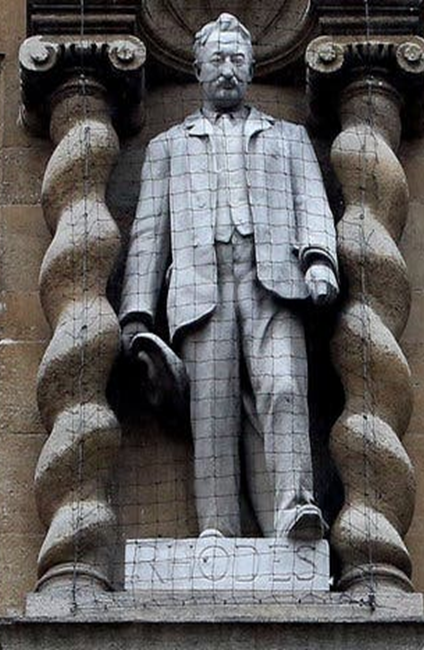 |
| 1a. King Leopold II, Antwerp, Belgium | 1b. Cecil Rhodes’ Statue, University of Oxford, Oriel College, UK |
As colonization was a “bundle” treatment, shaping early infrastructure, institutions, education, and cultural aspects, recent research largely abstracts from the macro-debate, quantifying the impact of specific parts of colonization.
Colonial Institutions
Inspired by the influential cross-country works of Acemoglu, Johnson & Robinson (2001, 2002), the first genre of studies examines the impact of European institutions related to forced labor, indirect rule, and oppression in specific contexts, often employing geo-spatial data and local identification designs. Lowes & Montero (2020) examine King Leopold II’s reign of the Congo Free State (1895-1908), one of the most infamous extraction cases. Employing a spatial regression discontinuity design, Lowes & Montero (2020) compare outcomes across the historical border of two major concessionary agreements that Leopold granted, which allowed firms to coerce locals to extract wild rubber. Present-day living conditions, literacy, schooling, health, and height appear significantly lower inside the historical concessionary boundaries subject to atrocities, violence, and brutal practices. Additionally, inside the historical concessionary limits, local chiefs seem more authoritarian, less likely to be elected by the community, and public good provision is lower.
Why did colonial extractive practices continue to matter decades after independence? Acemoglu, Reed & Robinson (2014) explore this by constructing a remarkable dataset comprising all chiefs that the British appointed in Sierra Leone in 1896-1903 and their descendants over the 20th century. Paramount chiefs, subordinate chiefs, and headmen ruled Sierra Leone’s interior throughout the colonial era, relying on violence and oppression. Chiefs’ power endured independence due to the country’s weak state capacity. Throughout the post-independence period, chiefs controlled land, settled disputes, taxed production, and allocated votes to their preferred candidates in national elections (see also Logan (2008) and Michalopoulos & Papaioannou (2015) for chiefs’ power).
These findings corroborate Mahmood Mamdani’s influential conjecture that colonization had lasting detrimental consequences by empowering unaccountable chiefs who preserved their power after independence.
Colonial Missionary Activity
Sir Thomas Fowell Buxton’s “The African Slave Trade and Its Remedy,” published in 1839, popularized the ideology that promoting commerce, education, and Christianity would facilitate development. Protestant and Catholic missionaries were often the first to build schools and clinics, encouraged by the colonial administration to minimize its costs and duties.
Most studies document positive long-run correlations between colonial mission schools and contemporary education (Cogneau & Moradi 2014), particularly for Protestant missions (e.g. Nunn 2014). Cagé & Rueda (2016) show that readership of newspapers, trust, and civic engagement is higher in areas close to missions with a printing press during early colonization. Huillery (2009) documents higher educational attainment rates in districts in which the French West African administration built more schools, while Fourie & Swanepoel (2015) document strong inertia between mission schools and contemporary education in South Africa. In a case study, Wantchekon et al. (2015) study educational persistence in Benin. Exploiting as-if-random assignment of first Christian schools across nearby villages, they uncover strong inertia and sizable local externalities. They also document considerably higher upward mobility in villages with colonial schools, a pattern that seems to apply more generally across the continent (Alesina, Hohmann, Michalopoulos & Papaioannou 2020).
These correlations are consistent with the idea that colonization’s impact on long-run development also operates via human capital, as emphasized by Glaeser et al. (2004). However, causality still remains an open issue. Christian missions and colonial schools did not locate randomly; rather, they considered the disease environment (malaria), local economic development (cash crops), and transport infrastructure (Jedwab, Meier zu Selhausen & Moradi 2019). Also, there is considerable heterogeneity in mission characteristics that future research needs to explore.
Colonial Infrastructure
Jedwab & Moradi (2016) and Kerby, Jedwab & Moradi (2017), among others, uncovered the positive impact of colonial road and railroad investments. Looking across 44 countries and zooming in on Ghana and Kenya, they show that local development is higher in areas close to colonial railroads. One problem for Africa has been very limited colonial-era railroad (and road) investments. Figure 2 illustrates this for Mozambique. In a colony larger than Germany and Poland put together, the Portuguese developed just three main and a couple of subordinate rail lines that connect the ports of Lourenço Marques, Beira, and Nacala to the interior. The objective was to ship minerals and agricultural goods out of the colony; there was no effort to connect the Southern with the Central and Northern provinces. Colonization effectively split Mozambique into three zones. This trichotomy is still present, as there are non-negligible differences in economic activity, education, and politics across these three regions.
Figure 2: Colonial railroads in Mozambique, 1890-1960
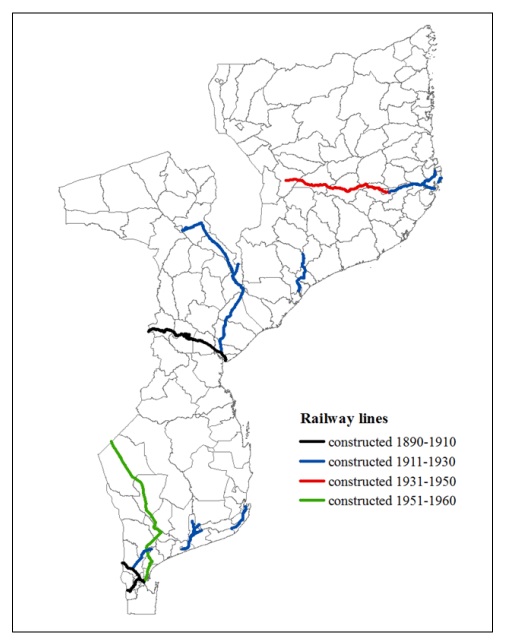
2. The Scramble for Africa
Colonization affected contemporary development even before it started. The artificial borders that colonizers drew in imprecise maps when they carved the largely unexplored continent (by Europeans) at the end of the 19th century endured beyond independence (Herbst 2000). British Prime Minister Lord Salisbury summarized the process: “we have been engaged in drawing lines upon maps where no white man’s feet have ever trod; we have been giving away mountains and rivers and lakes to each other, only hindered by the small impediment that we never knew exactly where the mountains and rivers and lakes were“. The colonial arrangements had little impact on the local populations initially as Africans could cross colonial borders, but the markings would later acquire salience upon independence. Henk Wesseling succinctly captures this process: “The partition of Africa was recorded by the Europeans on their maps, but the matter rested there for the time being…. In Europe conquests preceded the drawing of maps; in Africa the map was drawn, and then it was decided what was going to happen. These maps did not therefore reflect reality but helped to create it.”
The effects of the Scramble for Africa seem to operate via at least three channels. First, Africa is the continent with the largest share of landlocked countries: Niger, Chad, Burkina Faso, the Central African Republic, Rwanda, Burundi, and Uganda, among others, have suffered, as their ability to access world markets via global shipping routes depends on war-prone and unstable neighboring countries (Storeygard 2016). Second, for many states, their sprawling size and vast differences in geography, ecology, and topography limited their ability to broadcast power beyond the capitals (Michalopoulos & Papaioannou 2014; Herbst 2000). Third, artificial borders partitioned approximately a third of African ethnicities between different colonies and eventually countries.
In Michalopoulos & Papaioannou (2016), we examine the consequences of ethnic partitioning on contemporary conflict, overlaying spatial conflict data with anthropological maps on the spatial distribution of ethnicities during colonization. Figure 3a shows George Peter Murdock’s ethnographic map identifying (with blue) split ethnic homelands. Figure 3b maps conflict and violence incidents as recorded by the Armed Conflict Location & Event Data Project. First, homelands of partitioned ethnicities have been disproportionately affected by the conflict between state forces and rebels that have an explicit plan to overthrow the government. Second, violence against civilians, including village or church burnings, child soldiering, kidnappings, and abductions, has related to ethnic partitioning (see Figure 4). Third, countries often used split groups to stage proxy wars with their neighbors. Fourth, partitioned ethnicities have been more likely to engage in civil wars that have an explicit ethnic dimension. Since the early 1960s, roughly a third of split groups have participated in an ethnic-based civil war, while the share of non-split groups that have engaged in an ethnic war is around a fifth. Fifth, the likelihood that split ethnicities face discrimination in the political sphere is 10 percentage points higher for split than non-split groups (25% compared to 15%). Sixth, survey data show that education and public goods provision is significantly lower for individuals of partitioned ethnicities, even when compared to Africans from non-split groups in the same town. These results are in line with case studies and cross-country studies uncovering positive associations between ethnic partitioning and border artificiality with underdevelopment and conflict (Alesina, Easterly & Matuzseski 2012).
Figure 3: Ethnic homelands, national borders and violence in Africa
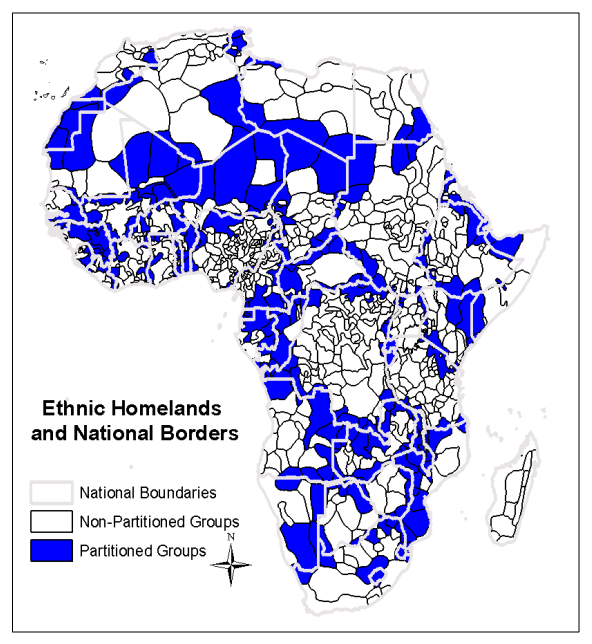
3a. Ethnic Homelands (Murdock 1959) and National Borders |
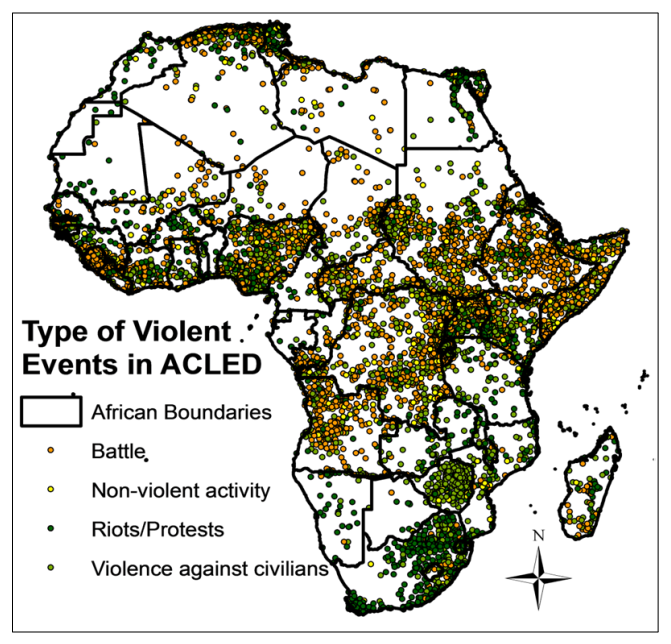
3b. Violence in Africa, 1997-2010 (ACLED) |
Figure 4: Ethnic partitioning and civil conflict (Michalopolous & Papaioannou 2016)
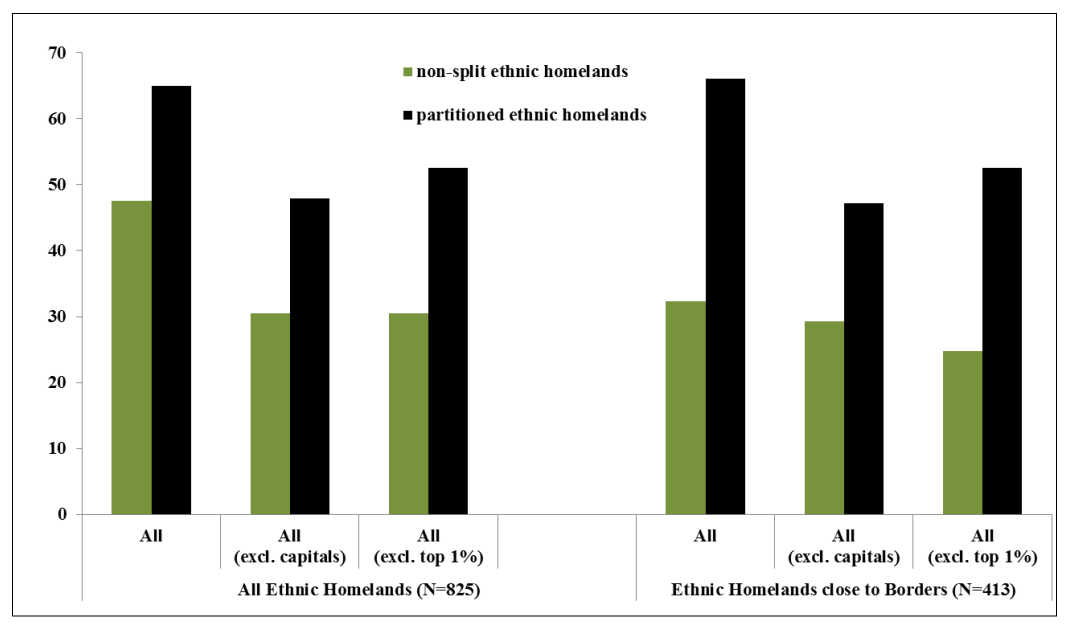
3. The Legacy of Africa’s Slave Trades
Between 1400 and 1900, Africa experienced four large slave trades. In the Transatlantic Slave Trade more than 12 million Africans, mostly from West Africa, were enslaved and then shipped to the Americas. On top of this, approximately 8 million Africans were enslaved in the East Africa, Red Sea, and trans-Saharan slave trades.
Figure 5: Slave exports by ethnicity and country
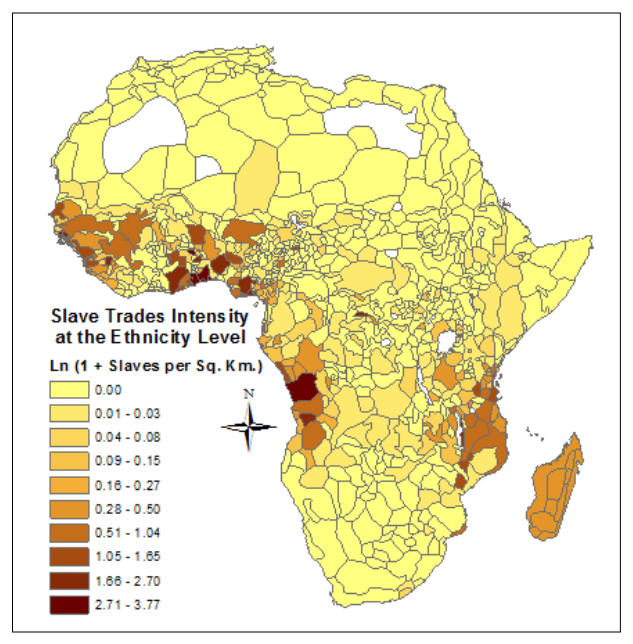 |
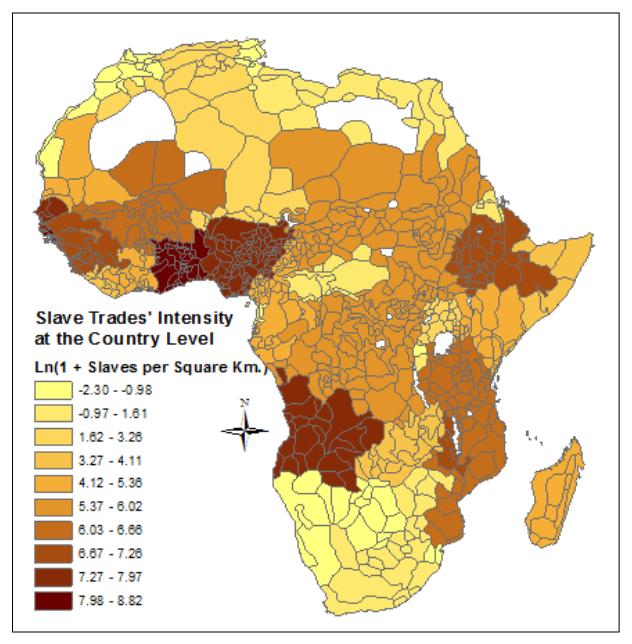 |
|
5a. Slave exports by ethnicity |
5b. Slave exports by country |
Nunn (2008) uncovered a strong link between Africa’s slave trades and contemporary development. Nunn merged shipment data on slaves’ ethnic affiliation (besides port) with Murdock’s map, delineating African ethnic boundaries and then examines the association of economic well-being and slave trade intensity (Figure 5). Figure 6 summarizes his core result. Economic development is, on average, lower in countries whose population was affected the most by the slave trades.. “Reverse causation” concerns are small, as the slave trades did not affect initially underdeveloped regions.
Follow-up papers shed light on the mechanisms. First, Nunn & Wantchekon (2011) uncover a link between enslavement and distrust. Second, slave exports altered the sex ratio, reinforcing the practice of polygyny that relates to the spread of HIV and under-investments in education (Teso 2017). Fourth, educational attainment is lower among ethnic groups affected the most, an interesting pattern as missionaries targeted the Slave Coast in their desire to “liberate” Africans (Okoye & Pongou 2015). Fifth, slave exports in the 16th-19th century correlate with contemporary conflict (Fenske & Kala 2017; Boxell 2018) and authoritarianism (Whatley 2014). Sixth, slave exports seem to partly explain Africa’s low levels of financial development (Pierce & Snyder 2017; Levine, Lin & Xie 2017).
Figure 6: Log real GDP per capita and slave exports (normalized by country’s area)
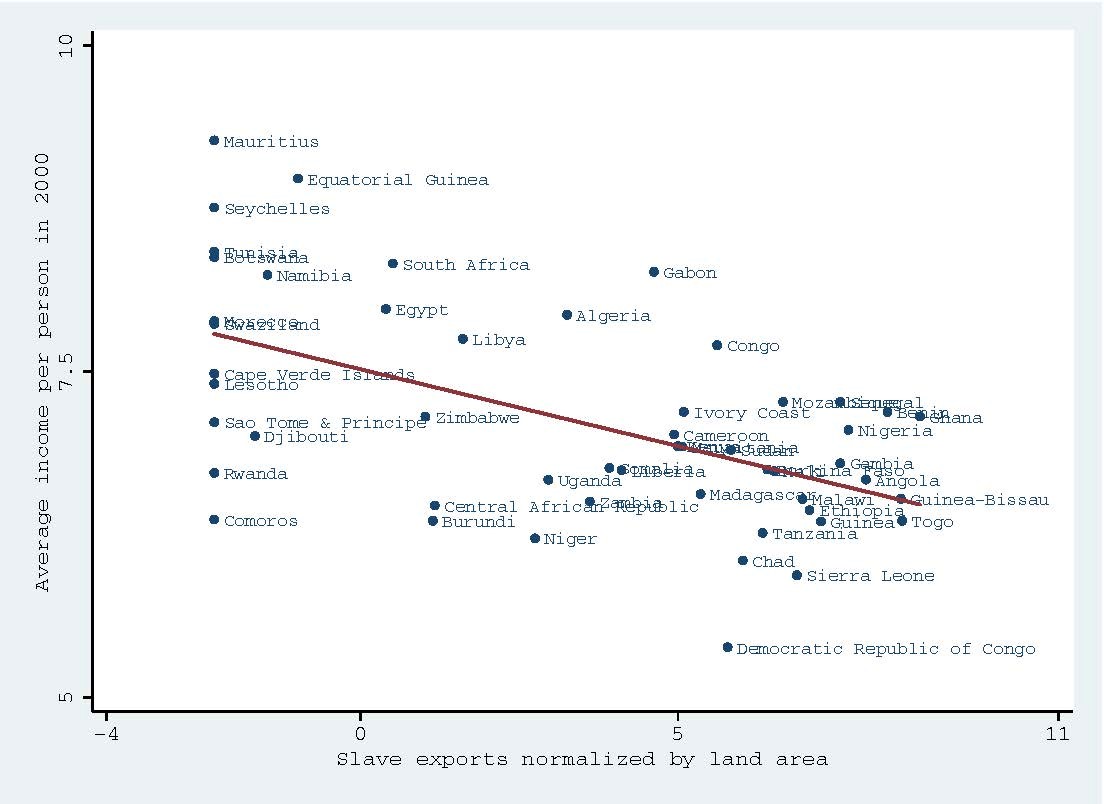
In Michalopoulos & Papaioannou (2013), we examine the role of precolonial political centralization, combining information on ethnicities’ political organization with satellite imagery on light density at night, which approximates economic development at the regional level. Compared to societies lacking political hierarchy beyond the local level (such as the Nuer or the Tiv), economic development is higher in small and especially large-paramount chiefdoms (such as the Asante). Regional development is the highest in the ancestral homelands of societies organized as states at the time of colonization (e.g. Zulus). These within-country associations, while not necessarily causal, are robust to the inclusion of various controls and even apply when we compare neighboring ethnic homelands in the same country.
4. Precolonial Ethnic-Specific Features and Contemporary Development
Our knowledge of precolonial Africa is limited. Nevertheless, the existing accounts suggest that there were large differences across ethnic groups in economic organization, political institutions, and societal structures before colonization. Vibrant research in cultural anthropology is trying to document, map, and understand the origins of differences in lineage, statehood, polygyny, and societal practices of African ethnicities.
Michalopoulos, Putterman & Weil (2018) examine how precolonial subsistence patterns, that differ across groups, ranging from hunter-gatherers to pastoralists and shifting and intensive agriculturalists, influence contemporary economic status. The authors show that the more one’s ancestral groups relied on agriculture, the better one’s economic outcomes are today. This long-term correlation is present within villages and city blocks, suggesting this is a robust pattern. The authors provide provisional evidence that political discrimination and traits related to propensity towards violence and impatience are higher among descendants of pastoralists. Along the same line, Alesina, Hohman, Michalopoulos & Papaioannou (2020) find that intergenerational mobility in educational attainment is higher among descendants of farming societies.
Moscona, Nunn & Robinson (2019) examine the legacy of kinship, which differed considerably across precolonial Africa. In segmentary lineage ethnicities, economic and social activities center on the family and along patrilineal or matrilineal lineages (where groups usually identify with a mythical ancestor). They find a trust gap for individuals from segmentary lineage ethnicities. The authors also show that segmentary lineage societies experience more conflict today.
Moving Forward
As always there are issues that future work is bound to address. To start with, we need better and more refined data on colonial institutions and investments in education, health, and infrastructure, ideally covering all of (sub-Saharan) Africa. Higher-quality data with a wider spatial coverage will not only allow us to improve our understanding quantitatively, but also explore heterogeneity, which is likely to be considerable, but hard to trace when focusing on specific case studies, irrespective of how well identified they are. The African Economic History Network publishes important works that dig into colonial archives and other historical records and allow us to study in great detail the multiple aspects of the colonial and precolonial era. In this area, the ongoing work by AEHN scholars, like Morten Jerven (2020) and Broadberry & Gardner (2019), to compile high-quality proxies of income and output going back to the colonial era is a very useful endeavor. Important works also in this direction are Frankema and van Waijenburg (2012, 2019) that reconstruct living standards (unskilled urban wages and welfare ratios) and skill premiums across the colonial era.
A related area regards mapping and understanding the evolution of historical inequality across space, ethnic, and religious lines. For example, Alesina et al. (2020) document sizable – though heterogeneous across countries – persistence in educational inequality across administrative regions. Regional differences in educational mobility relate to colonial investments and the human capital stock at independence. The AEHN provides exciting related works with more refined micro data. For example von Fintel & Fourie (2020) and Aboagye & Bolt (2018) map and study inequality at the Cape and in Ghana, respectively, while Baten, de Haas, Kempter and Meier zu Selhausen (2020) examine trajectories of gender differences in educational attainment.
Another area where progress is needed is in studying how colonial and precolonial features shaped the political equilibrium at independence and the post-independence economic trajectories. Future research should examine in detail in which periods colonial and precolonial legacies become salient and explore heterogeneity over time. This is interesting as historical features may interact with policies and macroeconomic shocks.
Another avenue is to examine interconnections between the main shocks; for example, how the slave trades affected colonization and precolonial ethnic institutions and vice versa (Whatley, 2014). Finally, as research on Africa’s economic history and research in development economics have blossomed in parallel, we believe that future work should break the “wall” and examine the role of historical legacies on the success or failure of various ongoing policy interventions, such as the study by Lowes & Montero (2020) on colonial vaccination campaigns.
As we stress in our review, the exploration of these inquiries should not only come from “outsiders”, but also from African scholars. Research on African development entails a “neocolonialist” element, often reflecting the views and biases of scholars from or educated in Europe and America. The next review of the literature should come from African scholars, working at African universities.
References
Aboagye Prince Young and Jutta Bolt. (2018). “Economic Inequality in Ghana, 1891-1960”, African Economic History Network Working Paper No. 38.
Acemoglu, Daron; Simon Johnson, and James A. Robinson (2001) “The Colonial Origins of Comparative Development: An Empirical Investigation“. American Economic Review 91(5): 1369–1401.
Acemoglu, Daron; Simon Johnson, and James A. Robinson (2002). “Reversal of Fortune: Geography and Institutions in the Making of the Modern World Income Distribution“. Quarterly Journal of Economics 117(4): 1231–1294.
Acemoglu, Daron, Tristan Reed, and James A. Robinson. (2014). “Chiefs: Economic Development and Elite Control of Civil Society in Sierra Leone.” Journal of Political Economy 122(2): 319–368.
Alesina, Alberto F; William Easterly, and Janina Matuszeski. “Arficial States“. Journal of the European Economic Association, 9(2): 246-277.
Alesina, Alberto; Sebastian Hohmann; Stelios Michalopoulos, and Elias Papaioannou (2020). “Intergenerational Mobility in Africa” Econometrica, forthcoming.
Alesina, Alberto; Sebastian Hohmann; Stelios Michalopoulos, and Elias Papaioannou (2020). “Ethnicity and Mobility in Africa”. Mimeo, LBS, Harvard, and Brown.
Baten, Jörg, Michiel de Haas, Elisabeth Kempter and Felix Meier zu Selhausen (2020). “Educational Gender Inequality in Sub-Saharan Africa: A Long-term Perspective”. African Economic History Network Working Paper No. 54.
Bates, Robert. (2008). When Things Fell Apart: State Failure in Late-Century Africa. Cambridge University Press, New York, NY.
Broadberry, Stephen and Leigh Gardner (2019). “Economic Growth in sub-Saharan Africa, 1885-2008″. Oxford Economic and Social History Working Papers No. 169.
Boxell, Levi. (2018): “Droughts, Conflict, and the African Slave Trade,” mimeo, Stanford University, Economics Department.
Cagé, Julia and Valeria Rueda (2016). The Long-Term Effects of the Printing Press in sub-Saharan Africa, American Economic Journal: Applied Economics 8(3): 69-99.
Fenske, James (2015). “African Polygamy: Past and Present,” Journal of Development Economics 117(2): 58-73.
Fenske, James and Namrata Kala. (2015). “Climate and the Slave Trade.” Journal of Development Economics 112(1): 19-32.
von Fintel, Dieter and Johan Fourie (2020). “The Great Divergence in South Africa: Population and Wealth Dynamics over two Centuries”, African Economic History Network Working Paper No. 47.
Fourie, Johan and Christie Swanepoel. “When selection trumps persistence: The lasting effect of missionary education in South Africa,” Tijdschrift voor Sociale en Economische Geschiedenis 12(1): 1-29.
Frankema, Ewout and Marlous van Waijenburg (2012). “Structural Impediments to African Growth? New Evidence from British African Real Wages, 1880-1965“. Journal of Economic History 72(4): 895-926
Frankema, Ewout and Marlous van Waijenburg (2019). “The Great Convergence. Skill Accumulation and Mass Education in Africa and Asia, 1870-2010″. CEPR Discussion Paper No. 14150.
Glaeser, Edward, Rafael La Porta, Florencio Lopez-de-Silanes and Andrei Shleifer (2004), “Do Institutions Cause Growth?“, Journal of Economic Growth 9(3): 271-303.
Herbst, Jeffrey (2000). States and Power in Africa, Princeton University Press, Princeton, NJ.
Huillery, Elise. (2009). History Matters: The Long Term Impact of Colonial Public Investments in French West Africa,” American Economic Journal: Applied Economics 1(2): 176—215.
Jerven, Morten (2020). African Economic Growth 1900-50: Historical National Accounts for British Colonial Africa. African Economic History Network Working Paper No. 50.
Kerby, Jedwab, and Alexander Moradi. (2017). “History, Path Dependence and Development: Evidence from Colonial Railroads, Settlers and Cities in Kenya,” Economic Journal 127(603): 1217—1729.
Levine, Ross, Chen Lin and Wensi Xie (2018). “The Origins of Financial Development: How the African Slave Trade Continues to Influence Modern Finance” NBER WP.
Jedwab, Remi, Felix Meier zu Selhausen and Alexander Moradi (2019). “The Economics of Missionary Expansion: Evidence from Africa and Implications for Development. African Economic History Network Working Paper No. 49.
Jedwab, Remi and Alexander Moradi. (2016). “The Permanent Effects of Transportation Revolutions in Poor Countries: Evidence from Africa.” Review of Economics and Statistics, forthcoming.
La Porta, Rafael, Florencio Lopez-de-Silanes, and Andrei Shleifer. (2008). “The Economic Consequences of Legal Origins.” Journal of Economic Literature. 46(2): 285-332.
Logan, Carolyn (2011). “The Roots of Resilience: Exploring Popular Support for African Traditional Authorities,” Afrobarometer Working Paper No. 128.
Lowes, Sara and Eduardo Montero. (2020). “Blood Rubber: The Effects of Labour Coercion on Institutions and Culture in the DRC.” Quarterly Journal of Economics, forthcoming.
Michalopoulos, Stelios and Elias Papaioannou (2013). “Pre‐Colonial Ethnic Institutions and Contemporary African Development“. Econometrica, 81(1): 113-152.
Michalopoulos, Stelios and Elias Papaioannou (2014). “National Institutions and Subnational Development in Africa“. Quarterly Journal of Economics 129(1): 151-213.
Michalopoulos, Stelios and Elias Papaioannou. (2015). “On the Ethnic Origins of African Development: Traditional Chiefs and Pre-Colonial Political Centralization,” Academy of Management Perspectives 29(1): 32-71.
Michalopoulos, Stelios and Elias Papaioannou. (2016). “The Long-Run Effects of the Scramble for Africa.” American Economic Review 106(7): 1802-1848.
Michalopoulos, Stelios and Elias Papaioannou. (2020). “Historical Legacies and African Development” Journal of Economic Literature 58(1): 53-128.
Michalopoulos, Stelios; Luis Putterman, and David Weil. (2019). “The Influence of Ancestral Lifeways on Individual Economic Outcomes in Sub-Saharan Africa.” Journal of the European Economic Association,. 17(4): 1186–1231
Moscona, Jacob; Nathan Nunn and James A. Robinson. (2019). Segmentary Lineage Organization and Conflict in Sub-Saharan Africa. Econometrica 88(5) : 1999-2036.
Moscona, Jacob; Nathan Nunn and James A. Robinson. (2017). Keeping It in the Family: Lineage Organization and the Scope of Trust in Sub-Saharan Africa. American Economic Review Papers and Proceedings 107(5) : 565-571.
Nunn, Nathan. (2008). “The Long Term Effects of Africa’s Slave Trades“. Quarterly Journal of Economics 123(1): 139-176.
Nunn (2014). “Religious Conversion in Colonial Africa,” American Economic Review Papers and Proceedings, 100(2), 147-152.
Nunn, Nathan (2014). “Gender and Missionary Influence in Colonial Africa,” in Africa’s Development in Historical Perspective, ed. by E. Akyeampong, R. Bates, N. Nunn, and J. A. Robinson, pp. 489—512. Cambridge University Press, New York, NY
Nunn, Nathan and Leonard Wantchekon (2011). “The Slave Trade and the Origins of Mistrust in Africa“, American Economic Review 101(7): 3221-3252.
Okoye, Dozie and Roland Pongou (2018). “Historical Missionary Activity, Schooling, and the Reversal of Fortunes: Evidence from Nigeria.” mimeo
Pierce, Lamar, and Jason. A. Snyder (2017): “The Historical Slave Trade and Firm Access to Finance in Africa,” Review of Financial Studies 31(1): 142-174
Storeygard, Adam. (2015), “Farther Down the Road: Transport Costs, Trade, and Urban Growth“, Review of Economic Studies 83(3): 1263-1295.
Teso, Edoardo. (2019). “The Long-Term Effect of Demographic Shocks on the Evolution of Gender Roles: Evidence from the Transatlantic Slave Trade” Journal of the European Economic Association 17(2): 497–534.
Wantchekon, Marko Klasnja and Natalja Novta (2015): “Education and Human Capital Externalities: Evidence from Colonial Benin,” Quarterly Journal of Economics, 130(2): 703-757.
Wesseling, H. L. (1996), Divide and Rule: The Partition of Africa, 1880-1914, Praeger, Amsterdam, Netherlands.
Whatley, Warren C. (2012): “The Transatlantic Slave Trade and the Evolution of Political Authority in West Africa,” MPRA Paper No. 44932.
Whatley, Warren C. (2015): “The Economic Legacies of the African Slave Trades.” The Oxford Handbook of Africa and Economics: Context ad Concepts. Edited by Célestin Monga and Justin Yifu Lin
[1] A collection of summaries of some influential studies on African colonization is available at “The Long Economic and Political Shadow of History, Volume 2”, VOXEU E-Book.
